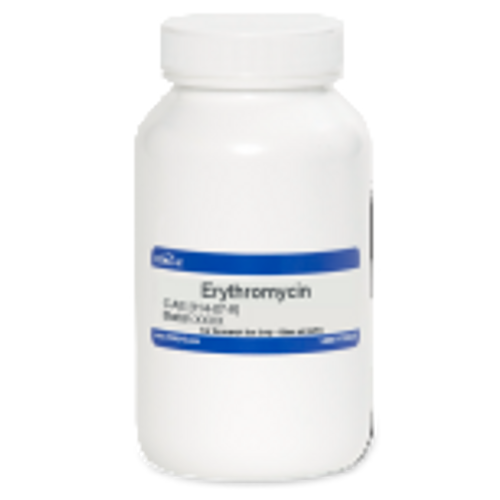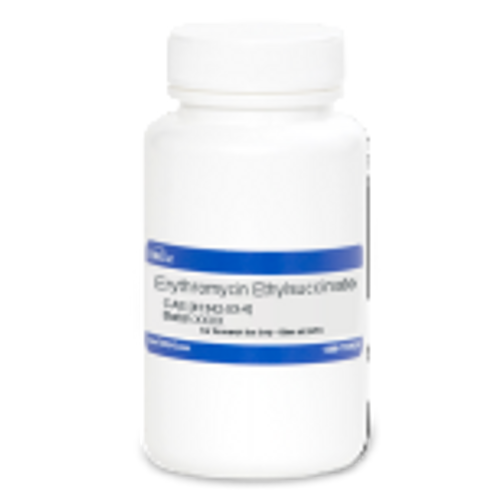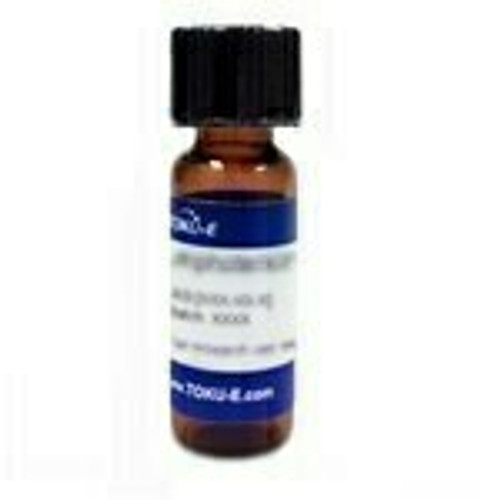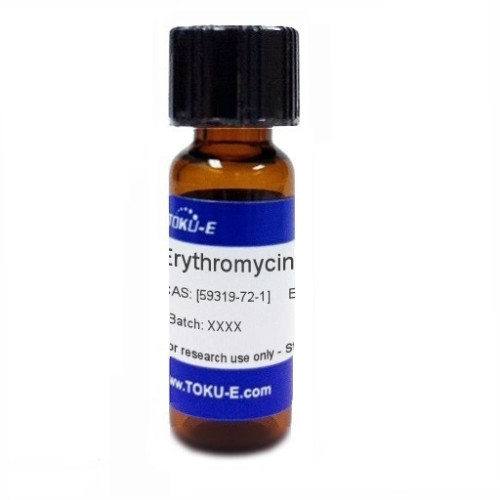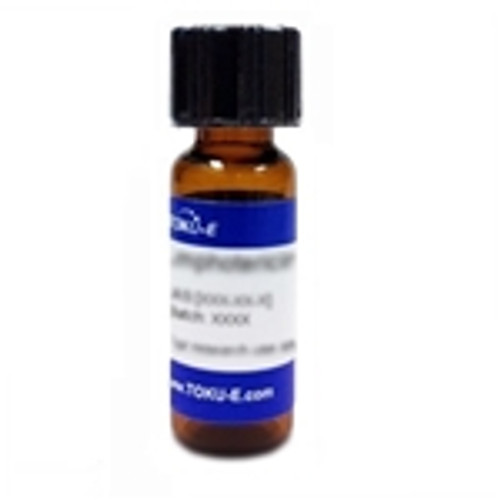Erythromycin is a broad-spectrum macrolide antibiotic derived from Saccharopolyspora erythraea (formerly Streptomyces erythraeus) that inhibits bacterial protein synthesis. It is composed largely of Erythromycin A, with small amounts of Erythromycin B and C. It is typically used at a concentration of 100 mg/L. Erythromycin is soluble in ethanol and 2M HCl but sparingly soluble in water.
For more Erythromycin products, click here.
| Mechanism of Action | Macrolide antibiotics inhibit bacterial growth by targeting the 50S ribosomal subunit preventing peptide bond formation and translocation during protein synthesis. Resistance to Erythromycin is commonly attributed to mutations in 50S rRNA preventing erythromycin binding allowing the cell to synthesize proteins free of error. |
| Spectrum | Erythromycin is a broad-spectrum antibiotic targeting Gram-negative and Gram-positive bacteria. It is also effective against Mycoplasma, Mycobacteria, and spirochetes. |
| Impurity Profile | Erythromycin A||7540-22-9|C37H67NO13|733.93| Erythromycin B| 12-deoxy erythromycin|527-75-3|C37H67NO12|717.9| Erythromycin C| 3"-o-demethyl erythromycin A|1675-02-1|C36H65NO13|720.92| Erythromycin D| 3"-o-demethyl-12-deoxy erythromycin A||C36H65NO12|703.45| Impurity A| Erythromycin F|82230-93-1|C37H67NO14|749.46| Impurity B| N-demethyl erythromycin A|992-62-1|C36H65NO13|719.91| Impurity C| Erythromycin E|41451-91-6|C37H65NO14|747.91| Impurity D| Anhydroerythromycin A|23893-13-2|C37H65NO12|715.91| Impurity E| Erythromycin A enol ether|33396-29-1|C37H65NO12|715.91| |
| Microbiology Applications | Erythromycin is commonly used in clinical in vitro microbiological antimicrobial susceptibility tests (panels, discs, and MIC strips) against Gram-positive, Gram-negative, and Mycoplasma species. Medical microbiologists use AST results to recommend antibiotic treatment options. Representative MIC values include:
|
| Plant Biology Applications | Erythromycin has been used in combination with nystatin and streptomycin for eliminating contaminants in rubber (Hevea brasiliensis) tissue culture (Leiffert et al, 1991). |
| Eukaryotic Cell Culture Applications | There is growing evidence that Erythromycin has anti-inflammatory properties and can be used to ameliorate airway inflammation. Using adult human T-cell leukemic cell line (Jurkat; clone E6-1), researchers found that Erythromycin could inhibit cytokine gene expression (specifically IL-8 gene) in T-cells and this mechanism is at the level of transcriptional regulation (Aoki and Kao, 1999). Erythromycin A is a potent stimulator of gastrointestinal motor activity. In vitro studies suggest that it mimics motilin, a peptide that stimulates motor activity in human and rabbit cells via smooth muscle receptors (Peeters et al, 1989). The anti-inflammatory action of Erythromycin was evaluated by looking at isolated neutrophils from human blood. When Erythromycin was applied, it shortened neutrophil survival in a dose-dependent way, with maximum effect at 10 mg/ml and above. It shortens neutrophil survival in part through elevating cAMP (cyclic AMP) levels. The result was accelerated apoptosis. Apoptosis may limit tissue injury by marking senescent neutrophils for phagocytosis and degradation by macrophages and by inhibiting the capacity of neutrophils to make injurious responses to inflammatory mediators (Aoshiba et al, 1995). |
| Cancer Applications | HERG (Human Ether-a-go-go Related Gene) may serve as a molecular marker and modulating target for individualized cancer therapy. Erythromycin, active as modulator and a HERG K+ channel blocker, suppressed the growth of various cancer cells and the potency was correlated with HERG expression levels. Erythromycin also enhanced the G2/M arrest induced by vincristine in HT-29 cells (Chen et al, 2005). |
| Solubility | Ethanol: Freely soluble Water: Sparingly soluble (2 mg/mL) Note: Solubility decreases with increasing temperature. |
| Source | Biosynthetic: Saccharopolyspora erythraea (formerly Streptomyces erythraeus). |
| References | Aoki Y and Kao PN (1999) Erythromycin inhibits transcriptional activation of NF-kappaB, but not NFAT, through calcineurin-independent signaling in T cells. Antimicrob. Agents Chemother. 43(11):2678-2684 PMID 10543746 Aoshiba K, Nagai A, and Konno K (1995) Erythromycin shortens neutrophil survival by accelerating apoptosis. Antimicrob. Agents and Chemother. 39(4):872-877 PMID 7785987 Chen S, Jiang M and Zhen Y (2005) HERG K+ channel expression-related chemosensitivity in cancer cells and its modulation by Erythromycin. Cancer Chemother Pharmacol 56: 212-220. PMID 15812674 Lovmar M and Tenson T (2003) The mechanism of action of macrolides, lincosamides and Streptogramin B reveals the nascent peptide exit path in the ribosome. Molec. Microbiol 330(5 ):1005-1014 PMID 12860123 Leifert C, Ritchie JY and Waites WM (1991) Contaminants of plant-tissue and cell cultures. World J. Microbiol. Biotechnol. 7: 452469 Oliynk M et al (2007) Complete genome sequence of the Erythromycin-producing bacterium Saccharopolyspora erythraea NRRL233338. Nature Biotechnol. 25:447-453 PMID 17369815 Peeters T et al (1989) Erythromycin is a motilin receptor agonist. Am. J. Physiol 257 (3):G470-G474 PMID 2782416 |
| MIC | Aggregatibacter actinomycetemcomitans| 8 - >32|| Alcaligenes faecalis (ATCC 1004)| 20|| Bacillus cereus| 0.0977 - 18|| Bacillus circulans (pH 7.0)| ≤0.03 - 16|| Bacillus pumilus (ATCC 14884)| 2 - 12.5|| Bacillus spp.| ≤0.12 - >16|| Bacillus subtilis| 0.12 - 412|| Bacteroides capillosus (pH 7.0)| ≤0.03 - 2|| Bacteroides fragilis| 0.25 - 128|| Bacteroides tectum | 0.25 - 1|| Bacteroides ureolyticus| ≤0.03 - 2|| Bifidobacterium adolescentis| 3.95|| Bifidobacterium animalis| >1.95 - <3.95|| Bifidobacterium bifidum| 7.8 - 15.62|| Bifidobacterium breve| ≤0.03 - 16|| Bifidobacterium Infantis| 15.6|| Bifidobacterium longum| ≤0.03 - 16|| Bifidobacterium pseudolongum| 3.9|| Bifidobacterium sp. | <0.98 - 3.9|| Bifidobacterium thermophilum| 0.98 - 1.95|| Bilophila wadsworthia| 4 - 32|| Borrelia afzelii| 0.0078 - 0.0625|| Borrelia bissettii | 0.0312 - 0.06|| Borrelia burgdorferi| 0.0039 - 1|| Borrelia garinii | 0.0078 - 0.0625|| Borrelia valaisiana| 0.0156 - 0.03|| Brachyspira hyodysenteriae| 4 - >256|| Branhamella catarrhalis| ≤0.08 - 0.6|| Brevibacterium casei| 0.5 - 4|| Brevibacterium spp.| ≤0.015 - >128|| Brucella| 0.5 - >256|| Brucella suis | 0.98 - 1.95|| Burkholderia cepacia| ≥128|| Campylobacter coli| 0.5 - >1024|| Campylobacter concisus| 0.125 - 2|| Campylobacter fetus| ≤0.06 - 4|| Campylobacter gracilis| 0.125 - 2|| Campylobacter jejuni| 0.125 ->1024|| Campylobacter lari| 8 - 32|| Campylobacter mucosalis| 0.125 - 2|| Campylobacter rectus| 0.125 - 2|| Campylobacter showae| 0.125 - 2|| Campylobacter spp.| ≤0.12 - 2|| Campylobacter sputorum| 0.125 - 2|| Capnocytophaga ochracea| ≤0.03 - 2|| Capnocytophaga spp.| 2|| Cellulomonas biazotea| 4|| Cellulomonas cellasea| ≤0.03|| Cellulomonas fermentans| 0.06|| Cellulomonas fimi| 4|| Cellulomonas flavigena| 0.25|| Cellulomonas gelida| 0.5|| Cellulomonas hominis| 1 - 2|| Cellulomonas uda| 0.5|| Chlamydia pneumonia| 0.008 - 0.5|| Chlamydia psittaci | 0.25|| Chlamydophila pneumonia| 0.015 - 0.25|| Citrobacter freundii| >16|| Clostridium clostridioforme| 0.25 - >32|| Clostridium difficile| 0.125 - 256|| Clostridium innocuum| 0.5 - >32|| Clostridium perfringens| 2|| Clostridium ramosum| 0.5 - >32|| Clostridium spiroforme| 1 - >8|| Collinsella aerofaciens| ≤0.03 - 0.125|| Corynebacterium| ≤0.06 - ≥64|| Corynebacterium afermentans| ≤0.015 - >128|| Corynebacterium amycolatum| 0.125 - >128|| Corynebacterium aquaticum| ≤0.12 - >16|| Corynebacterium argentoratense| ≤0.06 - ≥64|| Corynebacterium auris| ≤0.06 - ≥64|| Corynebacterium coyleae| ≤0.06 - ≥64|| Corynebacterium diphtheriae| ≤0.06|| Corynebacterium glucuronolyticum| ≤0.06 - ≥64|| Corynebacterium jeikeium| ≤0.015 - >128|| Corynebacterium macginleyi| ≤0.06|| Corynebacterium minutissimum| ≤0.015 - ≥64|| Corynebacterium mucifaciens| ≤0.06 - ≥64|| Corynebacterium pseudodiphtheriticum| ≤0.015 - ≥64|| Corynebacterium spp.| 1 - >8|| Corynebacterium spp.| 0.004 - >128|| Corynebacterium striatum| ≤0.015 - >128|| Corynebacterium ulcerans| ≤0.06|| Corynebacterium urealyticum| ≤0.015 - >128|| Coryneform| ≤0.015 - >128|| Dermabacter hominis| ≤0.06 - ≥64|| Dialister pneumosintes| ≤0.03 - 2|| Diphtheroids| 0.5 - >512|| Diplococcus pneumoniae| 0.002 - 0.02|| Edwardsiella hoshinae | 8 - 32|| Edwardsiella ictaluri | 4 - 64|| Edwardsiella tarda| 8 - 64|| Eikenella corrodens| ≤0.25 - >32|| Enterobacter aerogenes| >16|| Enterobacter cloacae| >16|| Enterococci| 0.25 - 128|| Enterococcus| ≤0.125 - 8|| Enterococcus avium| ≤0.12 - >64|| Enterococcus casseliflavus| ≤0.12 - >16|| Enterococcus cecorum| ≤0.12 - >16|| Enterococcus durans| ≤0.12 - >16|| Enterococcus faecalis| 0.1 - >512|| Enterococcus faecium| 0.1 - >512|| Enterococcus gallinarum| ≤0.12 - >128|| Enterococcus hirae| 0.1 - >100|| Enterococcus raffinosus| ≤0.12 - >16|| Enterococcus sp| 0.06 - >128|| Erwinia carotovora| 50|| Erwinia rhapontici| 5|| Erysipelothrix rhusiopathiae| 0.03|| Escherichia coli| 0.003 - 530|| Eubacterium lentum| ≤0.03 - 0.125|| Eubacterium saburreum| ≤0.03 - 0.06|| Eubacterium spp.| ≤0.03 - 0.125|| Eubacterium timidum| ≤0.03 - 0.125|| Eubacterium yurii | ≤0.03 - 0.125|| Finegoldia magna| ≤0.03 - >32|| Fusobacterium| 0.03 - 64|| Fusobacterium gonidiaformans | 1 - >32|| Fusobacterium mortiferum| 2 - >32|| Fusobacterium naviforme| ≤0.03 - >32|| Fusobacterium necrogenes | 2 - >32|| Fusobacterium necrophorum| ≤0.03 - >32|| Fusobacterium nucleatum| ≤0.03 - >32|| Fusobacterium russii | 1 - >32|| Fusobacterium ulcerans | 2 - >32|| Fusobacterium varium| ≥32|| Gemella spp.| ≤0.12 - >16|| Haemolytic streptococci| 0.06 - 8|| Haemophilus influenzae| 0.015 - >256|| Haemophilus parasuis| 0.25 - 8|| Haemophilus spp.| 0.25 - 128|| Helicobacter pullorum| 0.25 - 4|| Helicobacter pylori| 0.015 - >128|| Jonesia denitrificans| 0.25|| Klebsiella pneumonia| 0.09765 - 256|| Lactobacillus acidophilus| 0.98 - 12500|| Lactobacillus amylovorus| ≤0.12 - ≥256|| Lactobacillus brevis| 0.125 - 128|| Lactobacillus buchneri | ≤0.125 - 0.25|| Lactobacillus bulgaricus| 1.9 - 3.9|| Lactobacillus casei| 0.125 - 3.9|| Lactobacillus catenaforme| ≤0.03 - 16|| Lactobacillus crispatus| ≤0.12 - 0.25|| Lactobacillus curvatus| 0.125 - 128|| Lactobacillus delbrueckii| ≤0.03 - 16|| Lactobacillus fermentum| ≤0.12 - 4|| Lactobacillus gallinarum| ≤0.12|| Lactobacillus gasseri| ≤0.12 - ≥256|| Lactobacillus helveticus| ≤0.12 - 0.25|| Lactobacillus johnsonii| ≤0.12 - 100|| Lactobacillus lactis| 0.98|| Lactobacillus oris | ≤0.03 - 16|| Lactobacillus paracasei| ≤0.12 - 1024|| Lactobacillus pentosus| 64|| Lactobacillus plantarum| ≤0.03 - 512|| Lactobacillus reuteri| ≤0.25 - 512|| Lactobacillus rhamnosus| ≤0.12 - ≥256|| Lactobacillus sakei| ≤0.12 - 256|| Lactobacillus salivarius | ≤0.125 - 10|| Lactobacillus sp.| ≤0.03 - ≥500|| Lactococcus | ≤0.125 - 8|| Legionella adelaidensis| 0.125|| Legionella anisa| 0.5|| Legionella birminghamiensis| 0.5|| Legionella bozemanii| 0.256|| Legionella brunensis| 0.5|| Legionella cherrii| 0.25|| Legionella cincinnatiensis| 0.125|| Legionella dumofii| 0.143 - 0.5|| Legionella erythra| 0.75|| Legionella fairfieldensis| 0.032|| Legionella feeleii| 0.315|| Legionella geestiana| 0.25|| Legionella gormanii| 0.217|| Legionella gratiana| 0.5|| Legionella hackeliae| 0.5|| Legionella israelensis| 0.5|| Legionella jamestowniensis| 1|| Legionella jordanis| 1|| Legionella lansingensis| 0.188 - 0.375|| Legionella longbeachae| 0.008 - 0.5|| Legionella maceachernii| 0.5|| Legionella micdadei| 0.5 - 1|| Legionella moravica| 0.188|| Legionella nautarum| 0.125|| Legionella oakridgensis| 1|| Legionella pneumophila| 0.008 - 1|| Legionella quateirensis| 0.064|| Legionella quinlivanii| 0.188|| Legionella rubrilucens| 0.5|| Legionella sainthelensi| 0.25|| Legionella santicrucis| 0.25|| Legionella shakespearei| 1|| Legionella spiritensis| 0.25|| Legionella spp.| 0.25 - 1|| Legionella steigerwaltii| 0.375|| Legionella tucsonensis| 0.064|| Legionella wadsworthii| 0.25|| Leptotrichia buccalis| ≤0.03 - 16|| Leuconostoc | ≤0.125 - 8|| Leuconostoc mesenteroides| 16|| Leuconostoc pseudomesenteroides| ≤1|| Leuconostoc spp.| ≤0.12 - >512|| Listeria ivanovii| 0.047|| Listeria monocytogenes| 0.047 - >16|| Listeria spp.| 0.038 - >256|| Microbacterium spp.| ≤0.06 - 8|| Micrococcus| 17 - 29|| Micrococcus kristinae| 32|| Micrococcus luteus| 0.008 - 4|| Micrococcus spp.| ≤0.12 - >16|| Micromonas micros| ≤0.03 - 0.5|| Moraxella catarrhalis| 0.008 - 16|| Morganella morganii | >16 - >256|| Mycobacterium avium| 4 - >256|| Mycobacterium marinum| 8 - >32|| Mycobacterium smegmatis| 2.5 - 64|| Mycoplasma fermentans| >64|| Mycoplasma gallisepticum| ≤0.03|| Mycoplasma genitalium| ≤0.015|| Mycoplasma hominis| >32 - >64|| Mycoplasma hyopneumoniae| 8 - >64|| Mycoplasma iowae| ≤0.03|| Mycoplasma penetrans| 1 - 4|| Mycoplasma pneumonia| ≤0.001 - 16|| Mycoplasma synoviae| 16|| Neisseria cinerea| 1 - 8|| Neisseria gonorrhoeae| 0.015 - 1|| Neisseria lactamica| 2 - 4|| Neisseria meningitidis| ≤0.03 - 2|| Neisseria mucosa| 0.25 - 8|| Neisseria perflava/sicca| 0.5 - 16|| Neisseria polysaccharea| 0.06 - 4|| Neisseria sicca| 0.03 - 16|| Nocardia asteroides| 0.4 - ≥400|| Oerskovia spp.| ≤0.015 - >128|| Oerskovia turbata| 2|| Oerskovia xanthineolytica| 4|| Olsenella uli| ≤0.03 - 16|| Pasteurella multocida| 0.78|| Pediococcus | ≤0.125 - 8|| Pediococcus acidilactici (HA-6111-2)| 4|| Pediococcus pentosaceus| 16|| Pediococcus spp.| ≤0.12 - >16|| Peptostreptococcus| ≤0.015 - 64|| Peptostreptococcus anaerobius| ≤0.03 - >32|| Peptostreptococcus asaccharolyticus| 1 - >32|| Peptostreptococcus magnus| 1 - >32|| Peptostreptococcus micros| 0.5 - 1|| Peptostreptococcus prevotii| 0.03 - >32|| Peptostreptococcus spp.| 2 - 4|| Pneumococci| 0.06 - 128|| Porphyromonas| ≤0.015 - 64|| Porphyromonas asaccharolytica| 0.03 - 32|| Porphyromonas cangingivalis | ≤0.015 - 0.5|| Porphyromonas canoris | 0.03 - 0.25|| Porphyromonas cansulci | ≤0.015 - 0.5|| Porphyromonas circumdentaria | ≤0.015 - 0.5|| Porphyromonas endodontalis| ≤0.03 - 2|| Porphyromonas gingivalis| ≤0.03 - 8|| Porphyromonas levii | ≤0.015 - 0.5|| Porphyromonas macacae | 0.06 - 0.25|| Prevotella bivia| 0.06 - >32|| Prevotella buccae| ≤0.03 - >32|| Prevotella buccalis| ≤0.03 - >32|| Prevotella corporis| ≤0.03 - 16|| Prevotella dentalis| ≤0.03 - >32|| Prevotella denticola| ≤0.03 - 32|| Prevotella disiens| ≤0.03 - >32|| Prevotella heparinolytica | 0.25 - 0.5|| Prevotella intermedia| ≤0.03 - >32|| Prevotella loescheii| ≤0.03 - 16|| Prevotella melaninogenica| ≤0.03 - 16|| Prevotella nigrescens| ≤0.03 - >32|| Prevotella oralis| ≤0.03 - >32|| Prevotella oris| ≤0.03 - >32|| Prevotella pallens| ≤0.03 - >32|| Prevotella spp.| ≤0.03 - >32|| Prevotella tannerae| ≤0.03 - 16|| Prevotella zooglioformans| ≤0.03 - >32|| Propionibacterium avidum| ≤0.03 - 16|| Propionibacterium freudenreichii subsp. shermanii (131)| <0.25|| Propionibacterium granulosum| 0.06 - 0.125|| Proteus vulgaris| 0.048 - 512|| Pseudomonas aeruginosa| 0.1953 - 250|| Pseudomonas syringae| 6.25|| Rhodococcus equi| ≤0.015 - >4|| Rhodococcus spp.| ≤0.12 -32|| Salmonella enteritidis| 2 - >16|| Salmonella spp.| 128|| Salmonella typhi| 2.5 - >256|| Selenomonas flueggei| ≤0.03 - 2|| Selenomonas infelix| ≤0.03 - 2|| Selenomonas spp.| ≤0.03 - 2|| Serratia marcescens| 3.125|| Shigella flexneri| 64|| Shigella sonnei (Vero)| >16|| Sinorhizobium meliloti| 0.78|| Staphylococci| 0.06 - 128|| Staphylococci (coagulase-negative + methicillin-resistant)| ≤0.12 - >128|| Staphylococci (coagulase-negative + methicillin-susceptible)| ≤0.12 - >128|| Staphylococci (coagulase-negative)| ≤0.12 - >8|| Staphylococci| >128|| Staphylococci (erm(C)-inducible)| 1 - >128|| Staphylococci (erythromycin-susceptible)| 0.06 - 0.5|| Staphylococci (group A)| 0.125 - >64|| Staphylococci (group B)| 0.25 - >64|| Staphylococci (group C)| 0.25 - 16|| Staphylococci (group G)| 0.015 - 64|| Staphylococci (msr)| 1 - >128|| Staphylococcus (coagulase-negative + oxacillin-resistant)| ≤0.12 - >16|| Staphylococcus (coagulase-negative + oxacillin-susceptible)| ≤0.12 - >16|| Staphylococcus (coagulase-negative + Uruguay)| ≤0.5|| Staphylococcus (coagulase-negative)| ≤0.12 - >8|| Staphylococcus aureus| 0.023 - 1024|| Staphylococcus auricularis| ≤0.12 - >200|| Staphylococcus capitis | ≤0.12 - >200|| Staphylococcus caprae| 2|| Staphylococcus cohnii| 0.25 - 2|| Staphylococcus epidermidis| <0.03 - >200|| Staphylococcus haemolyticus| ≤0.12 - >200|| Staphylococcus hominis| ≤0.12 - >200|| Staphylococcus intermedius| ≤0.12 - >200|| Staphylococcus lugdunensis| ≤0.12 - >200|| Staphylococcus saprophyticus | ≤0.12 - >200|| Staphylococcus sciuri (LQC 5175)| 2|| Staphylococcus simulans | ≤0.12 - >200|| Staphylococcus spp.| ≤0.06 - >128|| Staphylococcus warneri| ≤0.12 - >200|| Staphylococcus xylosus | 2|| Stenotrophomonas maltophilia| 32 - 128|| Stomatococcus spp.| ≤0.12 - >16|| Streptococci| 0.008 - >512|| Streptococcus agalactiae| 0.01 - >64|| Streptococcus anginosus| ≤0.12 - >16|| Streptococcus bovis| 0.015 - >16|| Streptococcus constellatus| ≤0.12 - >16|| Streptococcus dysgalactiae| ≤0.06 - >32|| Streptococcus equi| 0.016|| Streptococcus equisimilis | ≤0.06 - >32|| Streptococcus faecalis| 256|| Streptococcus infantarius | ≤0.125 - 8|| Streptococcus intermedius| ≤0.12 - >16|| Streptococcus milleri| ≤0.12 - >16|| Streptococcus mutans| ≤0.12 - >16|| Streptococcus oralis| 0.06 - 8|| Streptococcus pneumonia| ≤0.004 - >256|| Streptococcus pyogenes| 0.004 - >256|| Streptococcus spp.| 0.015 - >32|| Treponema hyodysenteriae | 6.25 - >100|| Turicella otitidis| ≤0.015 - >128|| Ureaplasma spp.| 0.125 - 16|| Ureaplasma urealyticum| 0.5 - 2|| Veillonella spp.| ≤0.03 - >32|| Vibrio alginolyticus| >256|| Weissella spp.| ≤0.125 - 2|| Xanthomonas campestris| 50|| Yersinia enterocolitica| <0.25 - 64|| |

